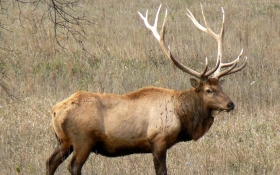
Elk
Cervus elaphus
Animal Behavior: Elk are social animals they live in summer herds with as many as 400 individuals. These herds are matriarchal and are dominated by a single cow. Seasonal migrations occur elevationally, with elk being found at higher elevations during summer, and migrating to lower elevations during winter. As the fall mating season approaches, bulls form harems, which they defend with their large size and aggressive nature. In spring, the sexes separate females leave to give birth, while bulls form their own separate summer herds. After birth, cows and their calves form nursery groups until calves are ready to join the herd. Bulls are only territorial during the mating season and are otherwise not aggressive toward other elk. Elk browse in the early morning and late evening . They are inactive during the day and the middle of the night, when they spend most of their time chewing their cud. Elk have a close association with white-tailed deer, sharing similar environments and similar habitats.
Eating Habits: Elk are browsers feeding on grasses, sedges, and forbs in summer and woody growth (cedar, wintergreen, eastern hemlock, sumac, jack pine, red maple, staghorn, and basswood) in the winter months. Favorites of the elk include dandelions, aster, hawkweed, violets, clover, and the occasional mushroom. Elk are ruminant animals and therefore regurgitate their food and remasticate to aid in digestion. This is also known as chewing cud.
Range: Elk prefer open woodlands and avoid dense unbroken forests. Elk can be found in coniferous swamps, clear cuts, aspen-hardwood forests, and coniferous-hardwood forests. They are found through a wide range of elevations, typically from sea level to 3000 m, although they can also occur at higher elevations.
Conservation Efforts: Elk have no special conservation status, but excessive hunting and habitat modification have lead to declines in their natural distribution and abundance. Most populations of Cervus elaphus were nearly extirpated in the 19th century. Recently, conservation measures by private citizens and Departments of Natural Resources have led to large increases in elk populations, putting C. elaphus out of danger. Elk are generally subject to limited, legal sport hunting and are farmed for meat in some western states.
Animal Facts: Elk range in color from dark brown in winter to tan in summer and have a characteristic buff colored rump. The head, neck, belly, and legs are darker than both the back and sides. Elk generally have a long head with large ears and widely branching antlers as long as 1.1 to 1.5 m from tip to tip are found on males only. A dark shaggy mane hangs from the neck to the chest. With a thick body, short tail and long slender legs, most elk stand approximately 0.75 to 1.5 m high at the shoulder and are 1.6 to 2.7 m from nose to tail.
